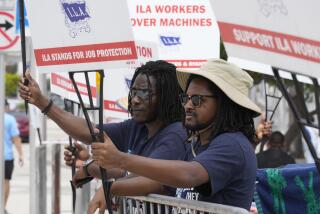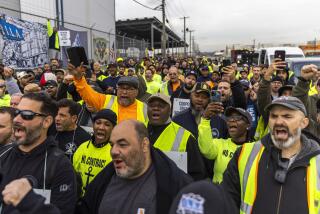Nassco Union Workers Strike for Better Wages : Labor: San Diego shipyard officials say company could go out of business if it meets union demands.
- Share via
SAN DIEGO — About 2,700 National Steel & Shipbuilding Co. workers went on strike Thursday as the company--the West Coast’s last major shipyard--threatened it could go out of business if it meets union demands.
Hundreds of the company’s 3,600 employees picketed after the strike began at 12:01 a.m. Thursday. Management and the seven striking labor unions said they were far apart in negotiations and no bargaining sessions were scheduled. However, a federal mediator is expected to bring the two sides together in a special bargaining session, which Nassco and union representatives agreed to attend.
Nassco cannot stay in business if it meets union demands, chief financial officer Fred Hallett said Thursday.
“We could not win new work, we could not be competitive if we pay wages higher than we have offered,” Hallett said. “We would price ourselves out of the market and eventually close, like the Lockheed yard did in Seattle and like Todd did in San Pedro.”
The recession and competition from foreign shipyards have brought havoc and bankruptcies to U.S. shipyards over the past decade. Only five major U.S. yards are left, and Nassco is the only one on the West Coast, Hallett said.
Union members said they are frustrated with their wages, which have not increased since 1987, and their steadily declining benefits and union rights.
The stoppage is unusual in that workers are striking against their own company. Nassco has been an employee-owned company since 1989. Nevertheless, more than 90% of 2,700 union members polled Wednesday voted to strike.
The walkout marks the biggest strike in San Diego in recent years.
Nassco management said the strike will slow but not shut down work at the yard at 28th Street and Harbor Drive.
Three Navy AOE-class combat support ships are under construction at the yard, and about half the company’s 900 management personnel will pick up tools beginning today to fill in for the striking workers, Hallett said.
Nassco offered workers a five-year contract with an average annual raise of 25 cents per hour above the average journeyman hourly wage of $12.72. In the three years since Nassco became an employee-owned company, workers have received an additional year-end profit-sharing bonus of 55 cents an hour.
The unions asked for a three-year contract with annual hourly raises of $1 the first year, $1 the second year and $2 the third year, said Peter Zschiesche, business representative with Machinists Union Local 389, the chief negotiator for the unions’ coordinated bargaining committee. But those demands will be reconsidered if non-wage issues such as seniority and health care costs can be settled, he said.
Zschiesche said some workers are bitter because the average journeyman wage is still not up to the $12.82 an hour in effect in 1987, when wages were cut $1.40 an hour in a cost-containment measure the union agreed to in order to keep the yard from closing.
The unions are also fighting a proposal to restrict the annual cost-of-living adjustment. Under the company’s plan, workers would get an increase only if inflation exceeds 4%.
The seven unions voting to strike are Carpenters Local 1300, Electricians Local 569, Iron Workers Local 627, Machinists Local 389, Operating Engineers Local 12, Painters Local 333 and Teamsters Local 36, Zschiesche said.
Nassco workers have struck at the end of each of their past four contracts, in 1981, 1984, 1987 and 1992. They went to a five-year contract after Sept. 30.
Nassco management, headed by Chairman Richard Vortmann, led an employee buyout from parent company Morrison-Knudsen in 1989. The agreement called for employees to get a third of all profits and 45% ownership interest in the company over a 10-year period through an employee stock-ownership plan.
The Navy has the right to halt work or remove ships under construction in the event of a strike. But the Navy decided Thursday after consulting with Nassco management to leave the ships where they are and to allow construction to proceed, Hallett said.
More to Read
Inside the business of entertainment
The Wide Shot brings you news, analysis and insights on everything from streaming wars to production — and what it all means for the future.
You may occasionally receive promotional content from the Los Angeles Times.










